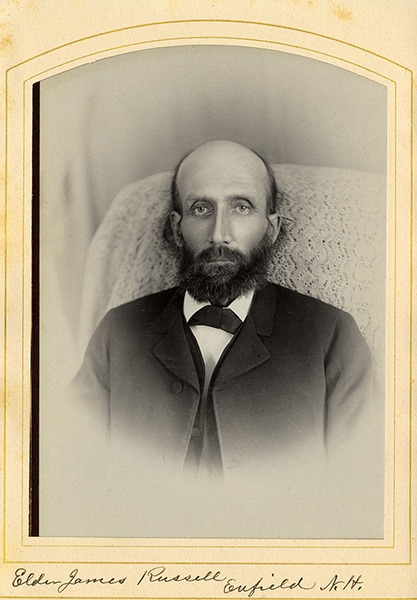
Carte de visite
C. E. Lewis, Photographer, Lebanon, NH, ca. 1880
Collection of Canterbury Shaker Village, Canterbury, NH
Elder James G. Russell
James G. Russell, Shaker musician and poet, was born July 29, 1843, in Norwich, Vermont, the son of Sylvester W. and Mary (Rand) Russell.
Sylvester and Mary Russell and their six children joined the Shakers in 1846. They were the last large family to embrace Shakerism at Enfield, New Hampshire. Although their son Sylvester, Jr., and daughter Ellen left the Society in adulthood, Sylvester and Mary, and four of their children (Isabella, James, Julia, and Aseneth) were lifelong members of the community. In the last four decades of the 19th century, Isabella, Julia, and James were especially important contributors to the strength and vitality of the Society.
James was only four years old when the family came to Enfield, so he received his entire formal education at the Shakers. His teachers served him well, for he clearly developed a lifelong love of learning. As a teenager, he did his share of work as a gardener, but his preference was for the classroom. His first teaching assignment was at the Second Family where, beginning in 1862, he taught the boys’ winter term. In 1865 he was put in charge of the larger school at the Church. Elder Abraham Perkins acknowledged that with a class of 25 boys, James needed a good deal of guidance and support that first year. With experience, James became a highly respected and beloved teacher.
In addition to teaching the 3 R’s, James became deeply interested in music. He had a passion for singing and learned everything he could about the human voice. In the 1860s he was using Shaker letteral notation to record the songs he received or composed, but he was also drawn to singing in harmony. He studied worldly treatises on standard notation, harmonic writing, and voice leading. When the Shakers began publishing a periodical, The Shaker (later known as The Shaker Manifesto) in 1872 James regularly submitted his four-part hymns for publication. Given the central role music played in Shaker worship, union meetings, and social gatherings, James wanted to encourage Shakers’ knowledge of music fundamentals, with the aim of strengthening the quality and energy of Believers’ singing. He held singing schools at Enfield and was soon looked to by other villages for instruction in good singing.
In 1874, James, his sister Isabella, and Shaker sister Eudora Arnold were granted permission to undertake a seven-week teaching tour of eastern Shaker villages. Their efforts were appreciated, and their teaching was praised by participants. Because of these extended visits to other communities, James developed relationships that he nurtured through letter writing and song exchange long after he returned to Enfield.
In 1876, the year of America’s great centennial exhibition in Philadelphia, James used the pages of The Shaker to further draw the world’s attention to the importance of music in Shaker worship. Each month an article appeared that discussed a particular aspect of good singing. He did not address Shaker practices specifically, but instead offered general observations that could be useful to anyone responsible for congregational or choral singing. Topics included maintaining standards of pitch accuracy, proper ventilation of singing spaces, anatomy of the singing voice, engaging the diaphragm for adequate breath support, changes in voice register and range, metric organization and time signatures, the particular demands of group singing, the use of instruments to teach and/ or support choral singing, and the importance of internalizing the pulse of a piece of music.
James carefully avoided taking a strong position on musical issues that were emerging within Shaker society as a whole. But the music he was writing reflected his love of four-part harmony, and his willingness to conform to the rigid metric organization typical of singing school collections being published in “the world.” James added many, perhaps hundreds of hymns and anthems to Shakerism’s post-Civil War repertoire. One of his lasting contributions, the anthem “Millennial Praises,” is still sung regularly by the Sabbathday Lake, Maine Shakers. James also turned his hand to poetry, and in several issues shared long poems with readers of The Shaker Manifesto.
In his correspondence with Elder William Leonard at the Harvard, Massachusetts Shaker community, James described himself as ”no candidate for theological distinction, no teacher, but simply a plain farmer with a desire for spiritual knowledge.” The depth of his questions, however, testify to his willingness to wrestle with challenging theological issues, not to undermine his faith, but to strengthen it. The serious response from his mentor is evidence of Leonard’s respect for James’ questions and his desire for intellectual engagement.
James, like his sister Aseneth, suffered from poor health. He was serving as Elder of the North Family (or novitiate order), when his tenure as a spiritual leader was tragically cut short by the onset of consumption. He was well aware of his failing condition and had two visionary experiences that helped him prepare for his impending death. He wrote an account of his visions for the June 1888 issue of The Shaker Manifesto (pp. 130-131) that was later included in the Shaker pamphlet, United Inheritance (c. 1888), by Watervliet Shaker brother Chancy Dibble.
Elder James G. Russell was 44 years and 9 months old when he died on May 3, 1888, at the Shaker community in Enfield, New Hampshire, or as he believed, when he entered his “next phase of life.” He is buried in the Church Family Shaker Cemetery in Enfield.
Original author: Mary Ann Haagen

